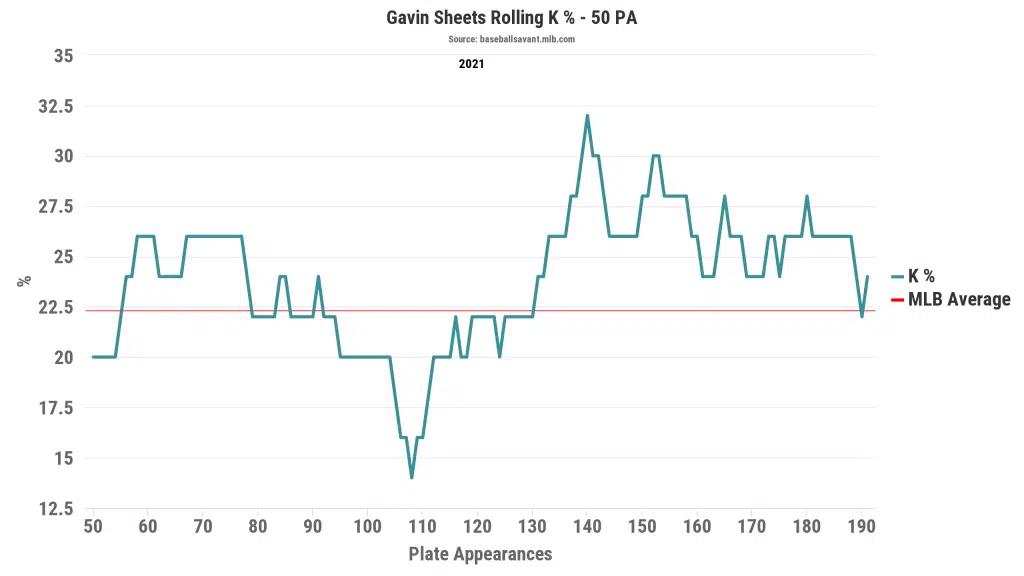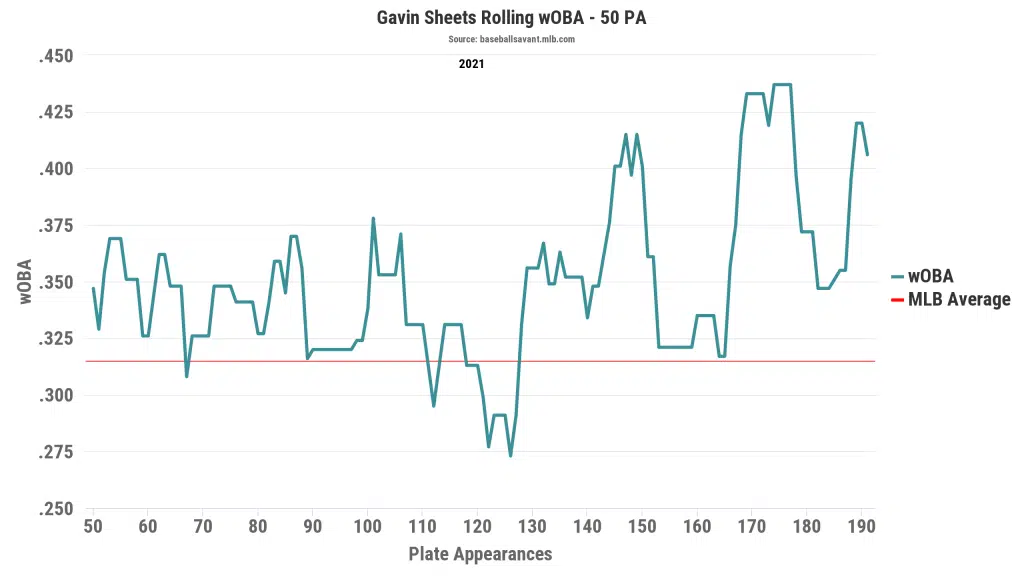Before we go anywhere, shout out to @ZGordz on Twitter for this article idea:
As White Sox fans have discussed the needs for the team this offseason, two have been mentioned ad nauseam: second base and right field. Everyone agrees those are the biggest needs. What most disagree on is which of those two positions should be the priority. Most point to the lack of internal options at 2B, making that the position of biggest need, as the White Sox have Andrew Vaughn and Gavin Sheets to hold down RF.
How accurate is this, however? In particular: how much stock should we be willing to put into Gavin Sheets’ short stint on the South Side?
Sheets – to his credit – slashed .250/.324/.506 in 179 PAs with a 9% walk rate and 22% strikeout rate, so there is a reason people are willing to give him more at-bats. At the same time, how much playing time should the White Sox be prepared to dedicate to him after just 179 PA?
With that, let’s dive into Gavin Sheets in 2021 as the White Sox prepare for 2022.
Sample Size and Comparison Points
Historical precedent is a great place to start for Sheets – how many hitters have done what he did in as few at-bats, and continued that production into the next season?
To dig into it a bit, I took a look at, over the course of the past 30 seasons, players with:
- 150-190 Plate Appearances on the Season (Sheets had 179)
- An OPS+ between 120 and 130 (Sheets’ was 123)
- At least an .800 OPS (Sheets’ was .830)
- At least a .480 SLG (Sheets’ was .506)
One of the biggest things to keep in mind is the sample size for what Gavin Sheets has done – there were just 24 results given the above parameters. Here they are, along with each player’s OPS+ in the following season:
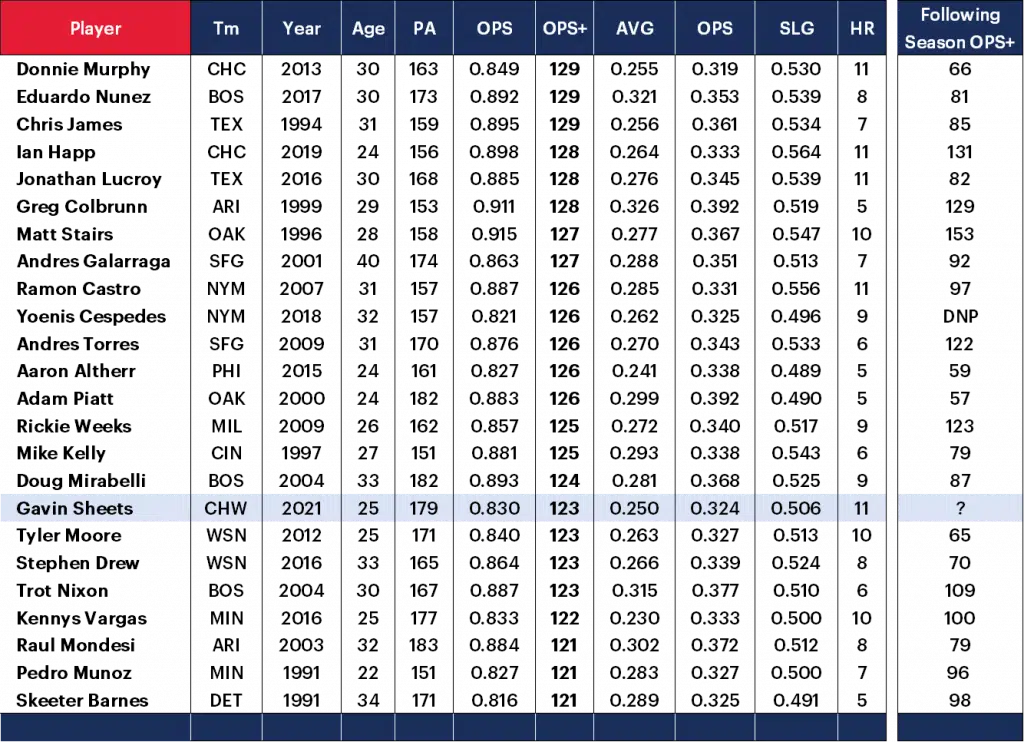
Nothing super easy to see from here – if anything, there’s little clarity in what happens year-over-year. If you look strictly at an OPS+ year-over-year, there’s almost no correlation.
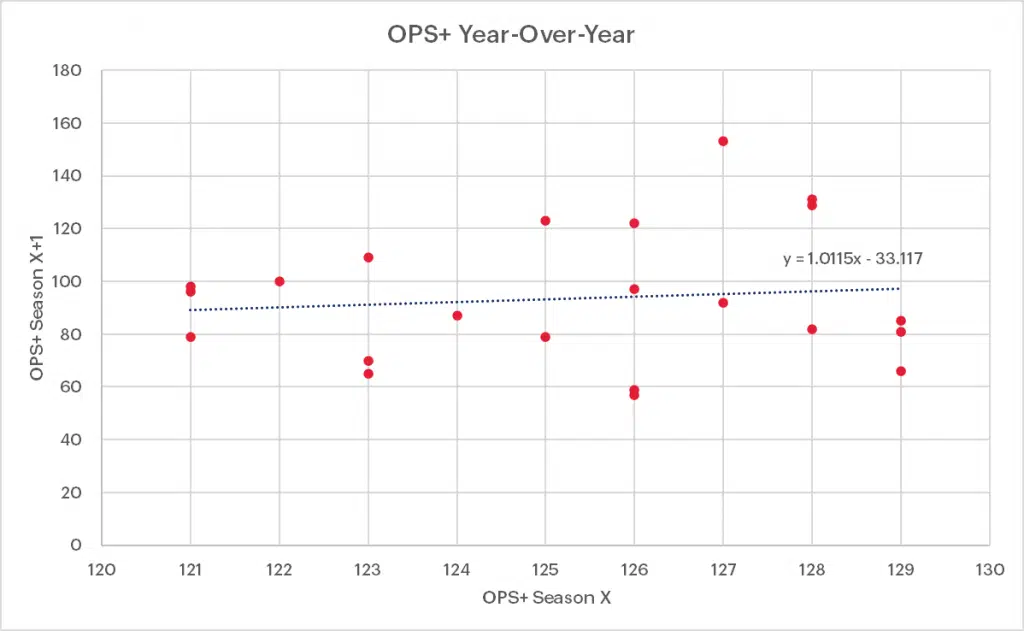
Sheets’ OPS+ would be projected to be around just 91 using this simple model of OPS+ year-over-year, which isn’t ideal.
However, if you look at the graph, there are a lot of players included who are much older than Sheets – aging might have been an important, unaccounted-for parameter.
Let’s take a look at the players 26 and under – which is how old Sheets will be in 2022.

There are just as many players who had brutal following seasons as those who had solid following seasons. We’re sitting 50-50 at best right now.
So, at first glance, we can’t point to much in the way of historical precedent that would make us bullish on Sheets’ chances to repeat his short-term 2021 success. What about in his overall game, however. Are there positive markers we can point to?
Offensive Approach
Though we looked at historical precedent above, not every player is the same. There are things we can look at with Gavin Sheets that make his production carry over from year to year.
My philosophy on hitters takes a look at their overall makeup as a player – when a player is struggling at the plate, do they have characteristics about their game that will allow them to provide value even if it isn’t in the form of hits? Knowing this, it probably doesn’t surprise you that some of my favorite players are Yasmani Grandal and Yoan Moncada – both of whom are more than willing to work the count and take walks. That’s a great way to provide value, even when you’re in a slump.
Let’s take a look at five facets of Gavin Sheets’ game to get a better understanding of the player he is.
1) Chase Rate
A definite strength of Sheets is his plate approach – someone who is willing to wait for his pitch and let the pitcher come to him. In order for a hot stretch to appear repeatable, there have to be characteristics about that streak that point to sustainability. A big point in Sheet’s favor is his chase rate – or lack thereof for someone his age.
He was among the team leaders in Chase Rate in 2021. It’s nothing to call home about, as it’s pretty middle of the pack in terms of the rest of the league, but it’s definitely a point in his favor:
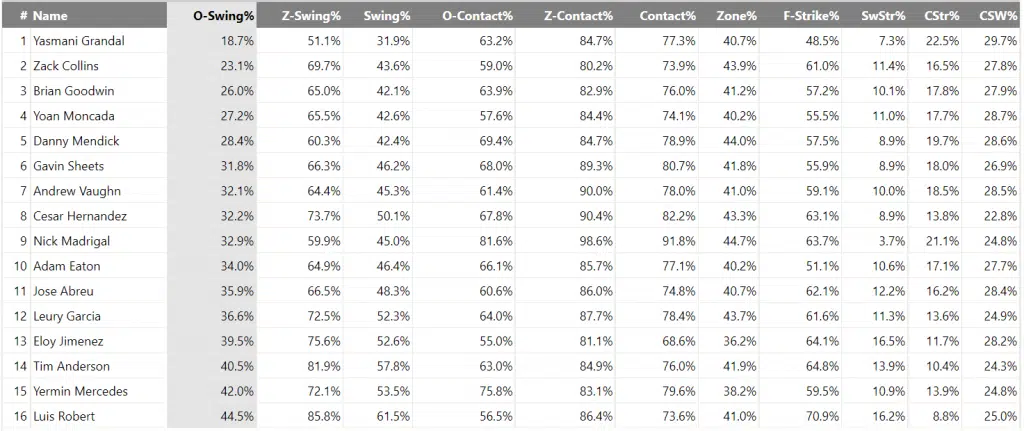
If Sheets can continue to refine his approach on pitches inside the zone while maintaining strong plate discipline and plate awareness, he will be more likely to be an important part of the offense in 2022.
2) Whiff Rate
Gavin Sheets is a big slugger-type profile. As we’ve seen with examples like Joey Gallo and Adam Dunn, these profiles often come with a lot of strikeouts as well. Sheets, to his credit, only struck out 22% of the time last season. As the season went on, Sheets showed his ability to hit fastballs, swinging and missing at just 14% of them in September.
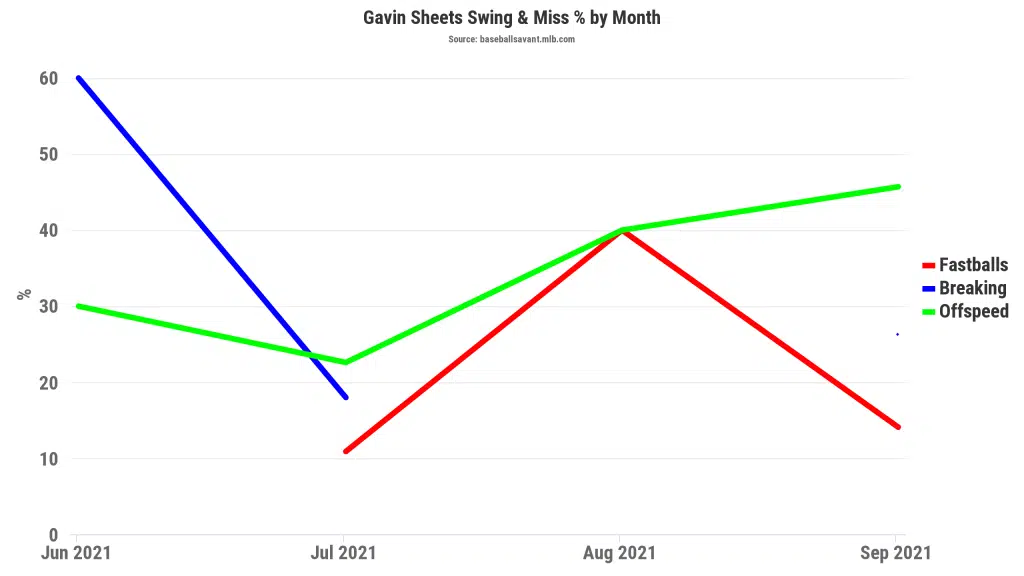
However, it’s pretty clear that he does still struggle with offspeed pitches – something to monitor heading into 2022. To his credit, however, when it’s been in the zone, he misses far fewer opportunities. While his Swing and Miss % was near 45% on all offspeed pitches, on those in the zone, it’s only around 29% – hardly elite, but an improvement.
If Sheets is going to be successful in 2022, it’s going to need to start with an improvement on handling breaking balls and offspeed pitches. However, one of the more positive things that happened to Sheets over the course of this season was his ability to understand and play into his profile. As the season progressed, his strikeout rate rose a bit – but so did his wOBA.
A clear key to success for Sheets? A combination of solid plate discipline, swing-and-miss prevention, and an acceptance of – and ability to play into – his player profile.
3) Quality of Contact
Despite his player profile, an interesting aspect of Sheets’ game is his ability to be more than a one-dimensional pull hitter. As we see in the chart below, Sheets goes the other way about a quarter of the time – more than respectable for a left-handed slugger. This ranks just outside the top 30 around Major League Baseball.
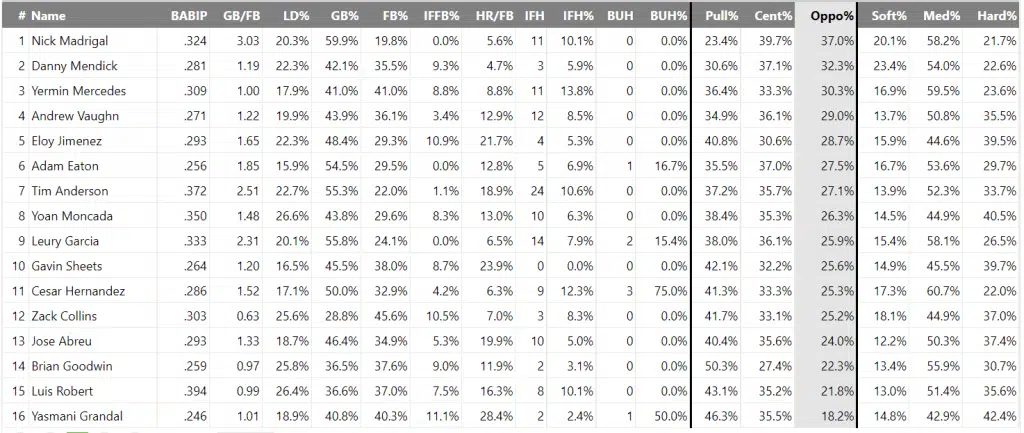
Here are some numbers on Gavin Sheets based on hit direction in 2021:

The expected numbers on both balls he pulls and hits straightaway are rather encouraging – it’s showing that his quality of contact is rather strong. This serves as one of the strongest points in his favor heading into 2022.
As for the difference between the expected statistics and actual statistics for opposite-field hitting, I don’t read too much into those. Yes, there’s clearly an element of luck associated with a .452 BABIP on 31 balls in play. However, much like an old article I wrote on Yoan Moncada, Gavin Sheets has the ability to benefit from the extreme shift teams utilize against him:
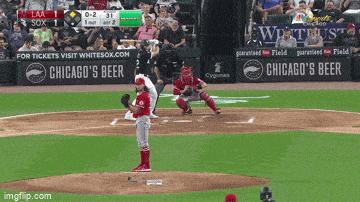
Bat control is an important part of separating Sheets from a “typical” power hitter and adding an additional element to his game. Going back to the original point about plate approach: if Sheets can shorten his approach at times to incorporate an opposite-field approach, it can keep him from falling into too many prolonged slumps.
However, it’s a game of give-and-take. So, Sheets should prioritize being a power hitter from the left side. But, at the same time, he clearly has the bat control to be a multi-faceted hitter.
4) Ground Ball Percentage
This is a pretty simple one: ball go far, team go far. Big guys like Sheets have no business putting the ball on the ground a significant portion of the time.
So, how does Sheets do in this area?
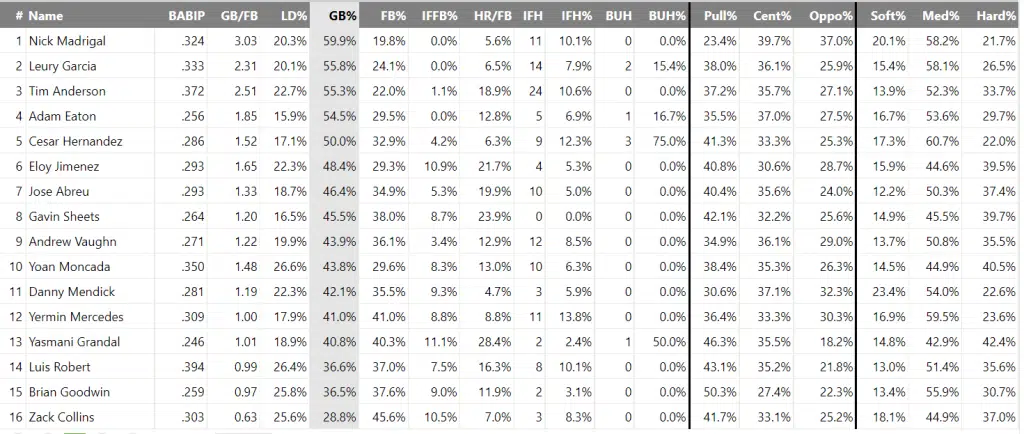
Given the team’s ground ball woes in 2021, it’s not exactly surprising to see Sheets about average on the team with a 45.5% ground ball rate. That’s about 40th in baseball among LHHs, so by no means is this bad. However, the best left-handed hitters keep the ball in the air.
To emphasize this point, here are Sheets’ numbers based on batted ball type.

Those numbers definitely hammer the point home. Sheets will be at his best if he keeps the ball off the ground. When he did, he posted some pretty impressive numbers.
5) Plate Discipline
We’ve already talked a bit about the 9% walk rate Sheets owns, along with some pretty solid chase rates, but I wanted to call out a really interesting tweet I saw from Jay Cuda recently that added to this article on Sheets’ repeat-ability.
If you’ve watched even a few White Sox games over the past two years, Moncada and Grandal being at the bottom of that list should not surprise you. But, having Sheets there as well points to the potential to be someone who stays willing to work counts, wait for his pitch, and adapt a solid approach at the plate. Perhaps he is molding himself as a Grandal-esque player:
It will be important for Sheets, however, to not fall so far into taking the first pitch of the at-bat that he automatically finds himself down 0-1 in the count. If he can find that balance, he has a better chance of repeating in his sophomore season.
6) Mechanical Changes
Being able to make adjustments is by far the most important part of repeating success consistently in the major leagues. Throughout the season, Sheets also made mechanical adjustments that showed an improving player.
Here’s a side-by-side image from Sheets’ first stint in the majors and after his return in September:
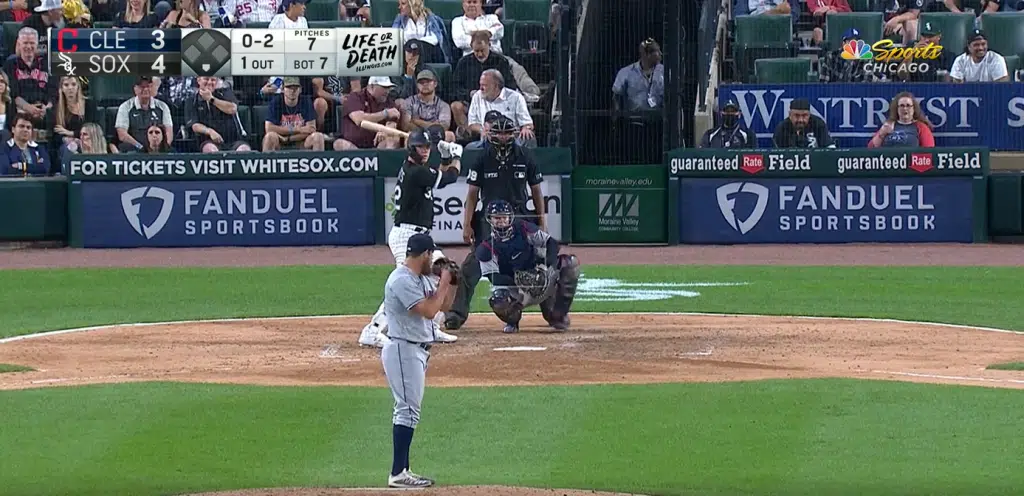
July 2021 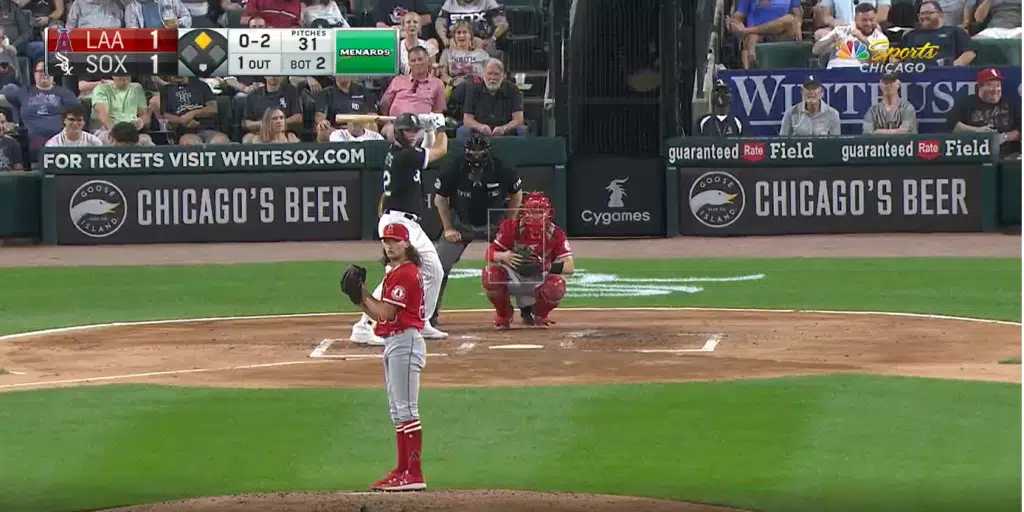
September 2021
Sheets is standing a bit taller by September after his return to the majors. His hands are closer to his body and higher up towards his head. This helped to remove some of the loop in his swing and allowed him to create a shorter attack plane to the ball.
In the grand scheme of things, this small change in approach may not be the most important part of Sheet’s ability to repeat his 2021 performance. However, it shows a willingness to make the necessary changes to achieve repeatability.
Defensive Shortcomings
Let’s just get right to it here: Gavin Sheets is not a major league right fielder. He played 105 innings in the outfield (LF and RF) in 2022 and posted these numbers:
- -2 OAA (Outs Above Average) in RF and -1 OAA in just 23 innings in LF
- -2 DRS in the OF, which translates to -22 DRS over the course of a season
- .941 fielding percentage, if that is your statistic of choice
Any way you slice it, it’s not great. Gavin Sheets, from a defensive standpoint, cannot be trusted to play 100+ games in right field in 2022. His bat is his calling card, and as a result, the White Sox should treat him as such.
None of this is necessarily Sheets’ fault, by the way. He’s a 1B by trade – it’s what he was drafted to be. It’s incredibly difficult to learn a new position.
Team Fit
Given what we’ve walked through above, should the White Sox be looking to get Sheets at-bats in the coming season? When he’s performing well, does he fill a role no one else in the lineup currently can?
This one is pretty simple: Sheets’ bat does fill an important gap in the White Sox’ lineup, mainly through his ability to his RHP. Sheets slashed .268/.344/.556 against RHP in 2021, cementing himself in the White Sox’ lineup as the season turned to October. However, he hasn’t had the same luck against LHP, mostly because of Tony La Russa‘s avoidance of putting him in too many situations to face LHP. He hit just .111/.158/.111 against LHPs in just 19 PAs.
Make no mistake, Gavin Sheets does have a spot on this roster. However, it will be up to the White Sox to best utilize this value heading into 2022.
So, based on the above, what is that value exactly?
Final Verdict
Let’s review what we’ve gone through thus far:
- Gavin Sheets has an interesting plate approach that isn’t overly aggressive. In order to repeat his performance in 2022, he will need to keep that approach while emphasizing improvement on offspeed pitches and hitting the ball in the air.
- Defensively, however, Sheets leaves much to be desired. If the White Sox have plans for him in 2022, they shouldn’t involve him playing the field all that much.
- Sheets does play an important role on this roster in terms of fit: a left-handed power bat that the White Sox could definitely use.
- All of this considered: there is still very little historical precedent that allows us to feel that additional confidence that Sheets’ performance is repeatable strictly on a rate basis.
The White Sox should absolutely be excited about the opportunity to keep Gavin Sheets as an important part of the team in 2022, and unless an undeniable trade opportunity presents itself, Tony La Russa will likely have Sheets at his disposal heading into the season.
However, with Andrew Vaughn looking to progress in 2022 as well, the White Sox will have an interesting situation on their hands with Vaughn, Sheets, and Jimenez on the same team. It will be hard to guarantee all of them playing time, so a situation develops in which the White Sox will need to put each player in the best position to win.
I think it’s far too soon to create a platoon situation between Vaughn and Sheets, simply because Vaughn is supposed to be a big part of the future for the White Sox. At the same time, I’m not willing to guarantee Sheets the lion’s share of at-bats at DH heading into 2022. There is still too much uncertainty in his play – though the same could be said for Andrew Vaughn. The way this plays out likely sees both players fighting for opportunities to make an impact throughout Spring Training.
This is a team with continued championship aspirations into 2022. Let’s not rely on too many players to perform roles that they are not meant to fill – at least not meant to fill just yet. Get some experienced players and create some much-needed depth, even if that means fewer at-bats on paper for Gavin Sheets. Close the gaps other ways via trades and free agency.
I do look forward to seeing what Gavin Sheets can do for the 2022 White Sox – but based on what we’ve seen, the team is better off having options, just in case.
Featured Photo: Chicago White Sox / Twitter

